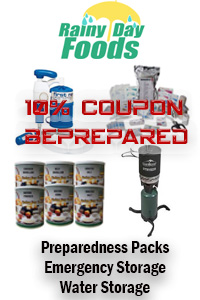Last week I posted up a contest, the prize being a Lifestraw Family water filtration device which was donated by the good folks at Eartheasy.com. If you haven’t checked out the EarthEasy website it doesn’t hurt to spend a few minutes going through it, they have wide range of products from chicken coops to solar ovens and even eco-friendly rechargeable lanterns.
Anyways, in order to participate in the contest people had to submit entries which detailed their biggest prepping mistake and how they resolved it. The winning response from J is below, along with a few others I selected to post below it.
Winning Response from J:
My biggest mistake to date in my prepping has been something that was so obvious I completely overlooked it. I know, we all say that after the fact; this one really gave me a dose of humility and changed the way I approach things in this particular area.
First, a bit of background to this story. My home is an older one, built in the early part of the 20th century with several additions to it over the years. It was originally a small place with a root cellar under it, which is fairly common for where I live. The cellar was given a halfhearted remodel during one of these periods of expansion and a cinder block wall was erected in front of the original stone and mortar walls. The floor is concrete and while it leaks a bit when it rains heavily, there is a sump that keeps everything pumped out. As my home is on basically the highest mean level around town, I thought little about the prospect of flooding, given the sump pump that was installed.
When I began prepping, I started with what I considered the basics, food and other common household supplies we often take for granted; toilet paper, toothpaste, over the counter meds, etc. Everything was stored on shelves and I was feeling really good about myself on the way things were progressing (even a bit smug, I can now admit). Who drops in for a visit? Everyone’s dear friend, Mr. Murphy.
There was a heavy snow storm for the area during this particular winter; followed by record warm temperatures. As you can guess, this saturated the ground, putting my much praised sump pump to good use. Then came a record level ice storm, causing a massive power failure virtually statewide. No power, no sump pump; and a generator was still a few places down on my list of things to buy. I lived in town and had never seen the power be out for more than a few hours at a time here. The outage lasted 2 days for us. In rural areas, others lost power for up to 2 weeks. The basement filled up overnight to waist level in near freezing temperature water. This basically ruined everything I had on the first 3 levels of my shelves, including the before-mentioned toilet paper, paper towels and meds. Also ruined were the rice, dried beans and pasta stores that I had in plastic containers, still in their original packaging. The canned goods were still ok, but the labels on many of them came off, due to the water damage. As we cycled through these, it was like playing “Wheel of Fortune” as far as canned vegetables for dinner.
I did manage to borrow a small generator from a friend who was in Florida during this time. I got everything pumped out with a minimum of damage to everything but foodstuffs and stored supplies. I learned a valuable and fairly expensive lesson from this, as well. The generator got moved up on the list to the next immediate purchase; foodstuffs have been replaced and work done to improve the basement. While it is impossible to stop the leakage problem, it has been significantly reduced. Items that are susceptible to water damage have been relocated to a better location, as well.
Also, canned goods that are stored also have an abbreviation as to what they are written in Sharpie marker on the tops!
I am able to poke fun at myself over this now and share a rather embarrassing lesson with others. This proved to be a very informative “Dry Run” (pun intended!) for my family and I. We all took some very valuable lessons from it.
Response from Kim:
Okay, I am a pretty new prepper and one of my greatest mistakes in putting together my survival go-bag, is not making a complete list of what I need and what I have purchased. While doing research on different websites and shopping for items on Ebay and Amazon, since I cannot afford to purchase everything at once and I was trying to get the best prices, I would pick up an item or two at a time and then put them in one box for storing and sorting until I had the majority of my gear and more importantly than that, I had to find the right survival bag to stock and carry my gear in. I have found that I have either purchased too much of certain things like first aid items, because I could not find a first aid kit that had everything I felt necessary in it, so by doing it piecemeal, I have ended up with a surplus of ointments, bandages, disposable scalpels, and so on. If I had made a master list of gear to go into my bag and checked them off when I ordered them, I would not have bought too many things and in some instances, I would not have purchased duplicates. There is a bright side to my madness. I am going to update my home first aid kit with those extras and with the extra survival gear, I am going to put together a separate go-bag to keep in my car, my main one will be at home, but this way, I won’t get caught unaware without anything if I am out and about.
Response from Yum Yucky:
My biggest mistake prepping so far has been lack of organization. It’s great to be buying my preps, but if they’re not organized in my space, the chances of me grabbing my prep in a hurry when it’s most needed is not real good. If I have to spend 30 minutes searching my prepping storage area for a specific prep, then I’ve failed (which has already been put to the test. Total failure!). I’m currently working on better organization in the basement.









9 comments
Skip to comment form
One thing, go for a diesel generator if you are going to get one.
Gasoline has a poor shelf life, as it is made of various components which evaporate easily, leaving behind gunk. When you go to start that generator after months, maybe a year, the carburetor will need to be cleaned.
Diesel engines will typically start right up… You can also make your own diesel. Forget about making gasoline.
You can improve your chances with a Gasoline generator if you drain the fuel or at a minimum use Stabil to increase the shelf life of the gas.
I have a tri-fuel generator, gasoline, natural gas and propane. I’ve run it on gasoline in the past, but now use propane. You can store propane indefinitely and we currently have 20 40 lb tanks stored in a fireproof shed near the generator.
What I’ve also begun doing, due to the high cost of Sta-bil and Pri-D, is filling my wife’s VW weekly from my gas cans and then refilling them when the pump price is lowest. I use the diesel in my JD 790 tractor and skid steer loader, so my fuel is never more than a couple of months old. I keep some Sta-bil and Pri-D on hand just in case.
J’s story happened to me 2 winters ago at my bug out location. Had 18 inches of water in the basement when I went to see why my security camera facing the basement door stopped working. I didn’t lose as much as he did, I’m just glad it was water and not 18 inches of ice.
Well, I once envied all of the folks with a basement. Not so much today 🙂
Basements are not practical where I live, so rarely will you see a house built with one. I never even thought about the need for a sump pump in a basement and what happens in a power outage.
Author
It’s a huge pain in the butt. Basements are great for storage and hanging out when the temps creep above 90 degrees but the potential for water associated problems is always there. My sump pump runs almost constantly but I have friends with pumps which almost never run, probably has to do with the water table in their area. My next home will not have a basement…
Basements are a bit of a mixed blessing. They are great as a storm shelter, should you need one. I grew up in tornado alley and learned that a basement or storm shelter needed to have a few things added to it. A lantern (I use a miner’s lantern, $10 at wall mart) as they will burn a solid 12 hours on one fill. Also, a small axe is recommended. If part of your house is destryoed, it is a good bet your basement door will not open easily, if at all.
To respond to Bruce’s post, I chose a gas generator over diesel with the thinking that if I had to have it for a prolonged time, gas is easier to get than diesel. there ares a lot more cars that run on gas, should i be reduced to siphoning. Not stealing, necessarily, but seeing what a tornado can do to a city gaurantees a lot of useless vehicles around. This is just one example. If I couldn’t leave, I have 2 vehicles of my own I could siphon from in an extreme circumstance.
Definitely will learn from J’s mistake. And as for Kim, I’ve been there already! Very creative contest, PJ. Congrats to J for the win.
Thanks, all.
One other thing I did not mention in the article, my furnace was also in the basemnent. This was also submerged, the control board and electrical connections…pretty much everything. I got lucky and managed to save it from having to be replaced, but doubt that it would survive a second time. Anyone with a similiar setup to the one I described, I would definitely recommend a backup generator, even if it was only small enough to keep your sump pump running.
GREAT INFO !!!!!!!!!!!!!!